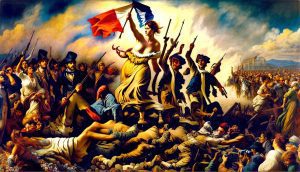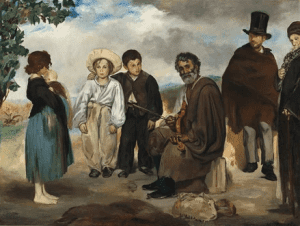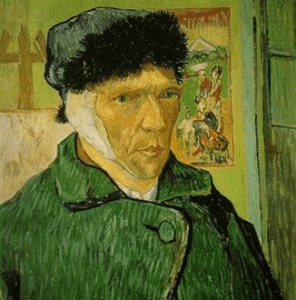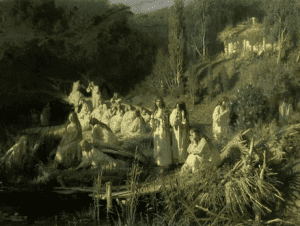(Skip to bullet points (best for students))

Born: 1798
Died: 1863
Summary of Eugène Delacroix
Delacroix is usually considered as the founder of the Romantic movement in French painting throughout the nineteenth century. His life and art represented the movement’s concern for passion, exoticism, and the sublime, and his painting style – full of rich, agitated brushwork and pulsing with vibrant colour – contrasted sharply with his peer and adversary, Ingres’ calm and controlled delineations. Delacroix disregarded academic norms in his subject selection, preferring large-scale depictions of modern events depicted in the most dramatic of styles, with obviously energetic brushwork and dynamic figural compositions.
Delacroix’s art exemplifies Romanticism’s fascination with the exotic Other, as shown in his paintings inspired by a life-changing journey to North Africa, but also in his animal paintings. Many of his works were based on firsthand observation of nature (he was a brilliant draughtsman and had an interest in early photography), which he then mixed with a narrative imagination, which is not unexpected considering his close relationship with many of the most prominent writers of the time.
Many of Delacroix’s Salon paintings portrayed dramatic scenarios based on current events and literature. Death of Sardanapalus and Massacre at Chios, for example, were startling for their ferocity and unashamed depiction of human suffering. These paintings heralded a new era in contemporary art, one in which emotional content took precedence above order and logic.
The love of all things wild and untamed is embodied in Delacroix’s animal paintings. He based these paintings on research he did in Paris’s Jardin des Plantes, where he sketched lions in the zoo and drew domestic home cats.
Delacroix’s simple still lifes are superb in their use of colour harmonies and arrangement and show the artist’s aim to master all creative disciplines as a real virtuoso. Impressionist painters would subsequently be influenced by these works, who reinterpreted the classic genre of still life in new and modern ways.
Delacroix received several important commissions in France to paint public buildings and churches. These ornamental undertakings, such as ceiling paintings and wall murals, permitted the artist to create on a wider scale than ever before and influenced the Nabis and other Symbolists who aspired to liberate painting from the easel.
Delacroix’s art’s aesthetic impact is due in large part to his study of colour; he grasped (and used) ideas like tone division and contrast harmony, both of which would be crucial for subsequent modernists like Van Gogh and Seurat.
Biography of Eugène Delacroix
Childhood
Eugène Delacroix’s birth is surrounded by controversy due to his father’s procedure to remove a testicular malignancy barely seven months before his birth. However, most historians think he was the youngest of four children born to Victorie Oeben and Charles Delacroix, Napoleon’s foreign minister. Delacroix’s early life was marked by tragedy since his father died when he was seven, his brother was killed in combat when he was nine, and his mother died when he was sixteen in 1814.
Delacroix was always interested in painting, even as a child. He began studying at the workshop of painter Pierre-Narcisse Guérin with the support of his uncle, artist Henri-François Riesener, and enrolled at the famous Ecole des Beaux-Arts in Paris at the age of eighteen.
Early Life
Delacroix’s first commission, for the church of Orcement in France, came in 1819, and he created The Virgin of the Harvest for it. Delacroix was asked to help with a commission for the Cathedral of Nantes by Théodore Géricault a year later; Delacroix painted the finished piece, Virgin of the Sacred Heart (1822), and divided the price with Géricault. When both men were pupils of Guérin, Delacroix befriended the elder artist. When Delacroix viewed Géricault’s Raft of the Medusa (1818-1819), he was deeply touched, and Géricault, in turn, recognised Delacroix’s brilliance.
Delacroix also got his first attack of tubercular laryngitis early in his career, which would torment him for the rest of his life, giving him continual anxiety about his health. He wrapped a scarf around his neck to try to prevent the disease from returning, which, while useful, also served to build his reputation as a stylish guy.
Delacroix, who was known for his independence, broke French artistic convention by refusing to compete for the coveted Prix de Rome (the traditional route for painters to acquire career recognition) and instead establishing himself through frequent exhibits at public Salons starting in 1822. He also deviated from classical subjects, favouring a more modern style in which he depicted dramatic storylines (often based on current events) in vibrant colours and dynamic compositions. Scenes from the Chios Massacres (1824), The Death of Sardanapalus (1828), and Liberty Leading the People are examples of this (1830).
These works cemented Delacroix’s reputation as a Romantic leader, a title he didn’t always like. He was known to hang around with the literary Romantics, notably Victor Hugo, the author. Hugo’s early admiration turned sour as he was dubbed “the Hugo of the palette.”
Mid Life
Delacroix’s 1832 voyage to Morocco with Count Charles de Mornay, Louis-special Philippe’s ambassador to the colony, was a watershed moment in his career (France conquered Algeria in 1830, and the North African country became a French colony). Delacroix was tasked with chronicling the diplomatic delegation’s six-month trip throughout the country in artworks. A visit to the Sultan, who gave Delacroix a horse, was one among the pleasures of the trip (that he later sold to fund the purchase of Moroccan objects he brought home with him).
Delacroix would create a whole body of work inspired by the sights, sounds, and odd new culture he experienced, particularly the people, their clothes, and the light and mood of the Mediterranean area. Finding models, on the other hand, was not always easy because many of the Muslims he met refused to pose for the artist due to their religion’s prohibition on the depiction of human images. As a result, many of Delacroix’s subjects were Jewish people who were more willing to welcome him into their homes to be sketched.
“The aspect of this country will remain forever in my eyes,” Delacroix wrote of the journey, “and the men of this noble race will live and move in my memory all my life long; it is they who have truly brought back to me the beauty of the ancients.” Delacroix was a prolific writer who kept diaries all of his life. In reality, his major diary was gathered and eventually published as a three-volume Journal series. The record, despite its value and insight into the artist, is not a conventional diary, since it covers a variety of information ranging from train timetables to addresses, memory aids, working techniques, and creative ideas.
Delacroix’s career was distinguished by significant public commissions after his return to France, notably the Salon du Roi and Library project at the Palais Bourbon, as well as murals for the Church of Saint-Sulpice. He also painted pictures for the Luxembourg Palace’s Chamber of Peers library. All of this ornamental labour was physically exhausting for Delacroix, so he began to spend more time in his country residence at Champrosay, where he could relax and recoup, beginning in 1844.
Late Life
He experienced spells of bad health later in life, which hampered his output (he had to stop working for a time in the early 1840s). Jenny Le Guillou, his housekeeper at the time, kept a close eye on his recuperation. Delacroix never married but was renowned for having relationships with a number of women, including his models and maybe even Le Guillou, with whom he lived until his death and to whom he left a self-portrait dated 1837.
Delacroix, a lifelong fan of literature and music, revelled in meetings that brought him into contact with the era’s most influential artists. For example, a contract to paint her picture led to a friendship with author Georges Sand and her boyfriend, musician Chopin. Sand was well-known for dressing as a man, and she did so for her photo, but Delacroix jokingly advised her against it, claiming that a man might be “a villainous beast.”
Delacroix took inspiration from nature in the final years of his career, painting several pieces depicting gardens and flowers. In 1850, he was chosen to paint a mythical scene on the main ceiling of the Louvre’s Apollo Gallery, and he continued to specialise in large-scale tableaux and decorations. This piece was so well received and regarded as a success that the artist was paid 6,000 francs more than the initial contract. Early modernist painters such as Odilon Redon, whose Pegasus and the Hydra (1905) was directly affected by Delacroix’s Louvre ceiling painting Apollo Slaying the Serpent, would be impacted by these paintings (1850-51).
Delacroix’s biggest foe was none other than Jean-Auguste-Dominique Ingres. It is believed that there was a great creative debate in the art world at the time, which could be characterised as a battle between colour and line. Colour was essential to Delacroix, while the line was vital to Ingres and the Neoclassicist tradition he was carrying on from David. Ingres requested that the Louvre’s windows be opened to air out the “smell of sulphur” that a previous visit by Delacroix allegedly left in the museum, according to one account.
Delacroix’s one-man exhibition at the 1855 Universal Exposition earned him widespread acclaim late in his career. While the Emperor intervened and insisted on the inclusion of his two most politicised and controversial works, The Death of Sardanapalus (1827) and Liberty Leading the People (1830), his two most politicised and controversial works were only added after the Emperor intervened and insisted on their inclusion. After this achievement, he was eventually elected to the Académie des Beaux-Arts in 1857, after seven previous tries.
Perhaps Delacroix’s most significant literary connection was with Charles Baudelaire, a much younger avant-garde poet and art critic who liked alcohol and opium and would later be charged with obscenity. Delacroix’s career was bolstered by Baudelaire’s backing, and he used his writing to promote his work. Baudelaire memorialised the artist in his 1863 book The Life and Work of Eugène Delacroix, describing him as “a volcanic crater artistically concealed behind bouquets of flowers” who “was passionately in love with passion, and coldly determined to seek the means of expressing it in the most visible way.”
Delacroix painted to the end of his life, but in his latter years, maybe as a consequence of personal introspection, he shifted his attention to Christian-themed paintings. Despite his impressive artistic output, he worried about his legacy near the end of his life, writing, “What will they think of me when I am dead?”
Delacroix’s significance goes beyond his pivotal and creative role in the Romantic movement. His subject matter, dramatic postures of his figures, focus on expression and emotion, the study of natural light in his outdoor landscapes and dramatic use of colour paved the way for the work of the early modern painters, most notably the Impressionists and subsequent Symbolists. Delacroix’s separation of tones, in particular, had a huge influence on Impressionist artists like Monet and Pissarro, and his understanding of the strength of complementary tones eventually led to Georges Seurat’s colour theories.
Eugène Delacroix Facts
What did Eugène Delacroix do?
As one of the finest French Romantic artists, Eugène Delacroix’s use of colour had a significant impact on the development of Impressionism and Post-Impressionism. He was born in Charenton-Saint-Maurice, France, on April 26, 1798, and died in Paris on August 13, 1863.
Did Eugene Delacroix ever marry?
It is possible that Delacroix had an affair with Le Guillou, who was with him till he died and to whom he left a self-portrait dated 1837. He never married.
Who was Delacroix inspired by?
Adolphe Theirs, a French aristocrat, hired Delacroix as his architectural decorator when he was just 24 years old. Many other Romantic painters like the Polish composer and pianist Frederic Chopin affected him in his formative years.
Why is Delacroix considered a Romantic painter?
A student of the Venetian School and the Baroque painter Peter Paul Rubens, Delacroix learned how to communicate movement and passion in his work through the use of vibrant colours and bold brushstrokes. This discovery laid the groundwork for all Romantic art to follow.
What does the name Delacroix mean?
In France, the surname Delacroix is derived from de la Croix (“of the Cross”). Eugène Delacroix (1798–1863), a French Romantic artist, may be the subject.
How many paintings did Delacroix Produce?
Eugene Delacroix was a prolific artist, producing more than 9,000 works of art during his lifetime, including paintings, watercolours, pastels, and drawings. The Impressionists and the Symbolists were both influenced by his work.
Famous Art by Eugène Delacroix
Scenes from the Massacres of Chios
1824

A group of distressed Greek men, women, and children lie gathered on the ground in the front of Delacroix’s canvas (some dead, some barely alive). A man dies from a stomach wound on the left, with his wife leaning on his shoulder; on the right, a dead mother leans against an elderly lady, her kid attempting unsuccessfully to suckle at her exposed breasts. A nude prisoner is being dragged by an Ottoman Turk behind them on the right, while a person tries in vain to stop him with upraised hands. As the ocean reaches the horizon line of a golden sky in the distance, less defined people are engaged in fight on the ruined terrain.
28 July: Liberty Leading the People
1830

The artwork by Delacroix Individuals of all ages charge over a canvas filled with dead bodies in 28 July: Liberty Leading the People. A bare-breasted female figure strides across the middle, holding a gun in her left hand and a French flag in her right, while she stares off to one side. Two guys stand to her right, one in a white shirt wielding a sabre and the other in a black jacket, tie, and top hat clutching a musket. A little child with two guns stands to the woman’s left. Only a faint trace of Paris can be seen in the backdrop, which is covered with smoke and ruin.
Lion Hunt
1861

A gang of Arab guys leads an attack on two lions in this dramatic and rather chaotic scenario. A female lion has slain a rider and his horse on the left, as another figure attempts to stab the lion from behind. Another huntsman gallops into the mayhem with sword lifted in the backdrop, near the peak of the roughly pyramidal composition. Four additional men can be seen in the foreground and to the right, attempting to kill a male lion who has cornered one of the hunters in his massive paws. Just beyond this group, a beast victim lies on the ground.
BULLET POINTED (SUMMARISED)
Best for Students and a Huge Time Saver
- Delacroix is usually considered as the founder of the Romantic movement in French painting throughout the nineteenth century.
- His life and art represented the movement’s concern for passion, exoticism, and the sublime, and his painting style – full of rich, agitated brushwork and pulsing with vibrant colour – contrasted sharply with his peer and adversary, Ingres’ calm and controlled delineations.
- Delacroix’s art exemplifies Romanticism’s fascination with the exotic Other, as shown in his paintings inspired by a life-changing journey to North Africa, but also in his animal paintings.
- Many of his works were based on firsthand observation of nature (he was a brilliant draughtsman and had an interest in early photography), which he then mixed with a narrative imagination, which is not unexpected considering his close relationship with many of the most prominent writers of the time.
- Many of Delacroix’s Salon paintings portrayed dramatic scenarios based on current events and literature.
- The love of all things wild and untamed is embodied in Delacroix’s animal paintings.
- He based these paintings on research he did in Paris’s Jardin des Plantes, where he sketched lions in the zoo and drew domestic home cats.
- Delacroix’s simple still lifes are superb in their use of colour harmonies and arrangement and show the artist’s aim to master all creative disciplines as a real virtuoso.
- Delacroix received several important commissions in France to paint public buildings and churches.
- These ornamental undertakings, such as ceiling paintings and wall murals, permitted the artist to create on a wider scale than ever before and influenced the Nabis and other Symbolists who aspired to liberate painting from the easel.
Information Citations
En.wikipedia.org, https://en.wikipedia.org/.
Recommend0 recommendationsPublished in Artists






Responses